Traceable Characterization of Nanomaterials by X-ray Spectrometry Using Calibrated Instrumentation
Abstract
:1. Introduction
2. Reference-Free X-ray Fluorescence Analysis
- is the incident radiation photon energy;
- / is the incident photon flux;
- is the signal of the photodiode recording the incident radiant power;
- is the spectral responsitivity of the photodiode;
- θ is the incident angle;
- Ei is the photon energy of the fluorescence line l of the element i;
- Ri is the detected count rate of the fluorescence line l of the element i;
- is absolute SDD efficiency at the photon energy Ei;
- is the intensity of the fluorescence line l of the element i;
- is the photo electric cross section of the element i at the photon energy ;
- is the absorption cross section of the sample s at the photon energy E.
- is the angle of observation with respect to the sample surface;
- Ωdet is the effective solid angle of detection defined by both a calibrated SDD aperture placed at a well-known distance from the sample and the incident beam foot print on the sample surface;
- ωXi is the fluorescence yield with respect to the (sub)shell or orbital Xi (of the element i);
- gl,Xi is the transition probability of the fluorescence line l associated with Xi;
- jXi is the ratio of the photo electric cross section of Xi to the sum of the photo electric cross sections of all other shells that can be ionized at ;
- Q = ωXi gl,Xi (jXi − 1)/jXi.
3. High-Resolution X-ray Spectrometry
4. Determination of Atomic Fundamental Parameter
5. Hybrid Metrology—Determination of Dimensional and Analytical Information of Nanomaterials
6. Operando Metrology—Time-Resolved Determination of the Analytical Information of Batteries
7. Conclusions
Funding
Institutional Review Board Statement
Informed Consent Statement
Data Availability Statement
Acknowledgments
Conflicts of Interest
References
- King, B. Metrology and Analytical Chemistry: Bridging the Cultural Gap. Metrologia 1997, 34, 41–47. [Google Scholar] [CrossRef]
- Seim, C.; Fleischmann, C.; Lépy, M.-C.; Boarino, L.; Hansen, P.-E.; Klapetek, P.; El Gawhary, O.; Petrik, P.; Beckhoff, B. (Eds.) 2017 E-MRS Spring Meeting Symposium S ALTECH 2017. In Proceedings of the Analytical Techniques for Precise Characterization of Nanomaterials, Strasbourg, France, 22–26 May 2017; WILEY-VCH: Weinheim, Germany, 2017; Volume 14, p. 1720017. [Google Scholar] [CrossRef]
- Nanoscaled Reference Materials: A Worldwide Survey of Existing Reference Materials at the Nanoscale in Different Categories by the German Federal Institute for Materials Research and Testing (BAM) in Cooperation with ISO/TC 229 Nanotechnologies. Available online: http://www.nano-refmat.bam.de/en/ (accessed on 31 January 2022).
- Beckhoff, B. Reference-Free X-ray Spectrometry Based on Metrology Using Synchrotron Radiation. J. Anal. At. Spectrom. 2008, 23, 845–853. [Google Scholar] [CrossRef]
- Hönicke, P.; Kolbe, M.; Müller, M.; Mantler, M.; Krämer, M.; Beckhoff, B. Experimental Verification of the Individual Energy Dependencies of the PartialL-Shell Photoionization Cross Sections of Pd and Mo. Phys. Rev. Lett. 2014, 113, 163001. [Google Scholar] [CrossRef] [PubMed]
- Beckhoff, B.; Gottwald, A.; Klein, R.; Krumrey, M.; Müller, R.; Richter, M.; Scholze, F.; Thornagel, R.; Ulm, G. A Quarter-Century of Metrology Using Synchrotron Radiation by PTB in Berlin. Phys. Status Solidi 2009, 246, 1415–1434. [Google Scholar] [CrossRef]
- Second Roadmap on Atomic Fundamental Parameters for X-ray Methodologies. International Initiative on X-ray Fundamental Parameters. 2017, 71. Available online: https://www.EXSA.hu/fpi.php (accessed on 31 January 2022).
- Guerra, M.; Sampaio, J.M.; Madeira, T.I.; Parente, F.; Indelicato, P.; Marques, J.P.; Santos, J.P.; Hoszowska, J.; Dousse, J.-C.; Loperetti, L.; et al. Theoretical and Experimental Determination OfL-Shell Decay Rates, Line Widths, and Fluorescence Yields in Ge. Phys. Rev. A 2015, 92, 022507. [Google Scholar] [CrossRef] [Green Version]
- Ménesguen, Y.; Gerlach, M.; Pollakowski, B.; Unterumsberger, R.; Haschke, M.; Beckhoff, B.; Lépy, M.-C. High Accuracy Experimental Determination of Copper and Zinc Mass Attenuation Coefficients in the 100 EV to 30 KeV Photon Energy Range. Metrologia 2015, 53, 7–17. [Google Scholar] [CrossRef]
- Beckhoff, B.; Fliegauf, R.; Kolbe, M.; Müller, M.; Weser, J.; Ulm, G. Reference-Free Total Reflection X-ray Fluorescence Analysis of Semiconductor Surfaces with Synchrotron Radiation. Anal. Chem. 2007, 79, 7873–7882. [Google Scholar] [CrossRef]
- Pollakowski, B.; Hoffmann, P.; Kosinova, M.; Baake, O.; Trunova, V.; Unterumsberger, R.; Ensinger, W.; Beckhoff, B. Nondestructive and Nonpreparative Chemical Nanometrology of Internal Material Interfaces at Tunable High Information Depths. Anal. Chem. 2013, 85, 193–200. [Google Scholar] [CrossRef]
- Pollakowski, B.; Beckhoff, B. Nondestructive Speciation Depth Profiling of Complex TiOx Nanolayer Structures by Grazing Incidence X-ray Fluorescence Analysis and Near Edge X-ray Absorption Fine Structure Spectroscopy. Anal. Chem. 2015, 87, 7705–7711. [Google Scholar] [CrossRef]
- Hönicke, P.; Beckhoff, B.; Kolbe, M.; Giubertoni, D.; van den Berg, J.; Pepponi, G. Depth Profile Characterization of Ultra Shallow Junction Implants. Anal. Bioanal. Chem. 2009, 396, 2825–2832. [Google Scholar] [CrossRef]
- Unterumsberger, R.; Pollakowski, B.; Müller, M.; Beckhoff, B. Complementary Characterization of Buried Nanolayers by Quantitative X-ray Fluorescence Spectrometry under Conventional and Grazing Incidence Conditions. Anal. Chem. 2011, 83, 8623–8628. [Google Scholar] [CrossRef]
- Fischer, T.; Dietrich, P.M.; Streeck, C.; Ray, S.; Nutsch, A.; Shard, A.; Beckhoff, B.; Unger, W.E.S.; Rurack, K. Quantification of Variable Functional-Group Densities of Mixed-Silane Monolayers on Surfaces via a Dual-Mode Fluorescence and XPS Label. Anal. Chem. 2015, 87, 2685–2692. [Google Scholar] [CrossRef]
- Dietrich, P.M.; Streeck, C.; Glamsch, S.; Ehlert, C.; Lippitz, A.; Nutsch, A.; Kulak, N.; Beckhoff, B.; Unger, W.E.S. Quantification of Silane Molecules on Oxidized Silicon: Are There Options for a Traceable and Absolute Determination? Anal. Chem. 2015, 87, 10117–10124. [Google Scholar] [CrossRef]
- Pollakowski-Herrmann, B.; Hornemann, A.; Giovannozzi, A.M.; Green, F.; Gunning, P.; Portesi, C.; Rossi, A.; Seim, C.; Steven, R.; Tyler, B.; et al. A Calibration Procedure for a Traceable Contamination Analysis on Medical Devices by Combined X-ray Spectrometry and Ambient Spectroscopic Techniques. J. Pharm. Biomed. Anal. 2018, 150, 308–317. [Google Scholar] [CrossRef]
- Giovannozzi, A.M.; Hornemann, A.; Pollakowski-Herrmann, B.; Green, F.M.; Gunning, P.; Salter, T.L.; Steven, R.T.; Bunch, J.; Portesi, C.; Tyler, B.J.; et al. A Methodological Inter-Comparison Study on the Detection of Surface Contaminant Sodium Dodecyl Sulfate Applying Ambient- and Vacuum-Based Techniques. Anal. Bioanal. Chem. 2018, 411, 217–229. [Google Scholar] [CrossRef]
- Grötzsch, D.; Streeck, C.; Nietzold, C.; Malzer, W.; Mantouvalou, I.; Nutsch, A.; Dietrich, P.; Unger, W.; Beckhoff, B.; Kanngießer, B. A Sealable Ultrathin Window Sample Cell for the Study of Liquids by Means of Soft X-ray Spectroscopy. Rev. Sci. Instrum. 2017, 88, 123112. [Google Scholar] [CrossRef]
- Witte, K.; Streeck, C.; Mantouvalou, I.; Suchkova, S.A.; Lokstein, H.; Grötzsch, D.; Martyanov, W.; Weser, J.; Kanngießer, B.; Beckhoff, B.; et al. Magnesium K-Edge NEXAFS Spectroscopy of Chlorophyll a in Solution. J. Phys. Chem. B 2016, 120, 11619–11627. [Google Scholar] [CrossRef]
- Unterumsberger, R.; Beckhoff, B.; Gross, A.; Stosnach, H.; Nowak, S.; Stenzel, Y.P.; Krämer, M.; von Bohlen, A. A Round Robin Test for Total Reflection X-ray Fluorescence Analysis Using Preselected and Well Characterized Samples. J. Anal. At. Spectrom. 2021, 36, 1933–1945. [Google Scholar] [CrossRef]
- Soltwisch, V.; Hönicke, P.; Kayser, Y.; Eilbracht, J.; Probst, J.; Scholze, F.; Beckhoff, B. Element Sensitive Reconstruction of Nanostructured Surfaces with Finite Elements and Grazing Incidence Soft X-ray Fluorescence. Nanoscale 2018, 10, 6177–6185. [Google Scholar] [CrossRef] [Green Version]
- Beckhoff, B.; Kanngießer, H.B.; Langhoff, N.; Wedell, R.; Wolff, H. (Eds.) Handbook of Practical X-ray Fluorescence Analysis; Springer: Berlin/Heidelberg, Germany, 2006. [Google Scholar] [CrossRef]
- Wählisch, A.; Streeck, C.; Hönicke, P.; Beckhoff, B. Validation of Secondary Fluorescence Excitation in Quantitative X-ray Fluorescence Analysis of Thin Alloy Films. J. Anal. At. Spectrom. 2020, 35, 1664–1670. [Google Scholar] [CrossRef]
- Seeger, S.; Osan, J.; Czömpöly, O.; Gross, A.; Stosnach, H.; Stabile, L.; Ochsenkuehn-Petropoulou, M.; Tsakanika, L.A.; Lymperopoulou, T.; Goddard, S.; et al. Quantification of Element Mass Concentrations in Ambient Aerosols by Combination of Cascade Impactor Sampling and Mobile Total Reflection X-ray Fluorescence Spectroscopy. Atmosphere 2021, 12, 309. [Google Scholar] [CrossRef]
- Kayser, Y.; Osán, J.; Hönicke, P.; Beckhoff, B. Reliable Compositional Analysis of Airborne Particulate Matter beyond the Quantification Limits of Total Reflection X-ray Fluorescence. Anal. Chim. Acta 2022, 1192, 339367. [Google Scholar] [CrossRef]
- Unterumsberger, R.; Hönicke, P.; Kayser, Y.; Pollakowski-Herrmann, B.; Gholhaki, S.; Guo, Q.; Palmer, R.E.; Beckhoff, B. Interaction of Nanoparticle Properties and X-ray Analytical Techniques. J. Anal. At. Spectrom. 2020, 35, 1022–1033. [Google Scholar] [CrossRef] [Green Version]
- Wansleben, M.; Vinson, J.; Holfelder, I.; Kayser, Y.; Beckhoff, B. Valence-to-core X-ray Emission Spectroscopy of Ti, TiO, and TiO 2 by Means of a Double Full-cylinder Crystal von Hamos Spectrometer. X-ray Spectrom. 2018, 48, 102–106. [Google Scholar] [CrossRef]
- Holfelder, I.; Wansleben, M.; Kayser, Y.; Gnewkow, R.; Müller, M.; Weser, J.; Zech, C.; Beckhoff, B. A Double Crystal von Hamos Spectrometer for Traceable X-ray Emission Spectroscopy. Rev. Sci. Instrum. 2021, 92, 123105. [Google Scholar] [CrossRef]
- Anklamm, L.; Schlesiger, C.; Malzer, W.; Grötzsch, D.; Neitzel, M.; Kanngießer, B. A Novel von Hamos Spectrometer for Efficient X-ray Emission Spectroscopy in the Laboratory. Rev. Sci. Instrum. 2014, 85, 053110. [Google Scholar] [CrossRef]
- Szlachetko, J.; Nachtegaal, M.; de Boni, E.; Willimann, M.; Safonova, O.; Sa, J.; Smolentsev, G.; Szlachetko, M.; van Bokhoven, J.A.; Dousse, J.-C.; et al. A von Hamos X-ray Spectrometer Based on a Segmented-Type Diffraction Crystal for Single-Shot X-ray Emission Spectroscopy and Time-Resolved Resonant Inelastic X-ray Scattering Studies. Rev. Sci. Instrum. 2012, 83, 103105. [Google Scholar] [CrossRef] [Green Version]
- Kayser, Y.; Błachucki, W.; Dousse, J.-C.; Hoszowska, J.; Neff, M.; Romano, V. Laboratory-Based Micro-X-ray Fluorescence Setup Using a von Hamos Crystal Spectrometer and a Focused Beam X-ray Tube. Rev. Sci. Instrum. 2014, 85, 043101. [Google Scholar] [CrossRef] [PubMed] [Green Version]
- Schlesiger, C.; Anklamm, L.; Stiel, H.; Malzer, W.; Kanngießer, B. XAFS Spectroscopy by an X-ray Tube Based Spectrometer Using a Novel Type of HOPG Mosaic Crystal and Optimized Image Processing. J. Anal. At. Spectrom. 2015, 30, 1080–1085. [Google Scholar] [CrossRef] [Green Version]
- Alonso-Mori, R.; Kern, J.; Sokaras, D.; Weng, T.-C.; Nordlund, D.; Tran, R.; Montanez, P.; Delor, J.; Yachandra, V.K.; Yano, J.; et al. A Multi-Crystal Wavelength Dispersive X-ray Spectrometer. Rev. Sci. Instrum. 2012, 83, 073114. [Google Scholar] [CrossRef] [PubMed]
- Malzer, W.; Grötzsch, D.; Gnewkow, R.; Schlesiger, C.; Kowalewski, F.; Van Kuiken, B.; DeBeer, S.; Kanngießer, B. A Laboratory Spectrometer for High Throughput X-ray Emission Spectroscopy in Catalysis Research. Rev. Sci. Instrum. 2018, 89, 113111. [Google Scholar] [CrossRef] [Green Version]
- Zastrau, U.; Woldegeorgis, A.; Förster, E.; Loetzsch, R.; Marschner, H.; Uschmann, I. Characterization of Strongly-Bent HAPG Crystals for von-Hámos X-ray Spectrographs. J. Instrum. 2013, 8, P10006. [Google Scholar] [CrossRef]
- Grigorieva, I.; Antonov, A.; Gudi, G. Graphite Optics—Current Opportunities, Properties and Limits. Condens. Matter 2019, 4, 18. [Google Scholar] [CrossRef] [Green Version]
- Gerlach, M.; Anklamm, L.; Antonov, A.; Grigorieva, I.; Holfelder, I.; Kanngießer, B.; Legall, H.; Malzer, W.; Schlesiger, C.; Beckhoff, B. Characterization of HAPG Mosaic Crystals Using Synchrotron Radiation. J. Appl. Crystallogr. 2015, 48, 1381–1390. [Google Scholar] [CrossRef]
- Wansleben, M.; Vinson, J.; Wählisch, A.; Bzheumikhova, K.; Hönicke, P.; Beckhoff, B.; Kayser, Y. Speciation of Iron Sulfide Compounds by Means of X-ray Emission Spectroscopy Using a Compact Full-Cylinder von Hamos Spectrometer. J. Anal. At. Spectrom. 2020, 35, 2679–2685. [Google Scholar] [CrossRef]
- Wansleben, M.; Kayser, Y.; Hönicke, P.; Holfelder, I.; Wählisch, A.; Unterumsberger, R.; Beckhoff, B. Experimental Determination of Line Energies, Line Widths and Relative Transition Probabilities of the Gadolinium L X-ray Emission Spectrum. Metrologia 2019, 56, 065007. [Google Scholar] [CrossRef] [Green Version]
- Lühl, L.; Andrianov, K.; Dierks, H.; Haidl, A.; Dehlinger, A.; Heine, M.; Heeren, J.; Nisius, T.; Wilhein, T.; Kanngießer, B. Scanning Transmission X-ray Microscopy with Efficient X-ray Fluorescence Detection (STXM-XRF) for Biomedical Applications in the Soft and Tender Energy Range. J. Synchrotron Radiat. 2019, 26, 430–438. [Google Scholar] [CrossRef]
- Shin, H.-J.; Kim, N.; Kim, H.-S.; Lee, W.-W.; Lee, C.-S.; Kim, B. A Scanning Transmission X-ray Microscope at the Pohang Light Source. J. Synchrotron Radiat. 2018, 25, 878–884. [Google Scholar] [CrossRef]
- Steinmann, R.G.; Martinez-Criado, G.; Salomon, D.; Vitoux, H.; Tucoulou, R.; Villanova, J.; Laboure, S.; Eymery, J.; Segura-Ruiz, J. A Helium Mini-Cryostat for the Nanoprobe Beamline ID16B at ESRF: Characteristics and Performance. J. Synchrotron Radiat. 2020, 27, 1074–1079. [Google Scholar] [CrossRef]
- Martínez-Criado, G.; Villanova, J.; Tucoulou, R.; Salomon, D.; Suuronen, J.-P.; Labouré, S.; Guilloud, C.; Valls, V.; Barrett, R.; Gagliardini, E.; et al. ID16B: A Hard X-ray Nanoprobe Beamline at the ESRF for Nano-Analysis. J. Synchrotron Radiat. 2016, 23, 344–352. [Google Scholar] [CrossRef] [Green Version]
- Mino, L.; Borfecchia, E.; Segura-Ruiz, J.; Giannini, C.; Martinez-Criado, G.; Lamberti, C. Materials Characterization by Synchrotron X-ray Microprobes and Nanoprobes. Rev. Mod. Phys. 2018, 90, 025007. [Google Scholar] [CrossRef]
- Johannes, A.; Salomon, D.; Martinez-Criado, G.; Glaser, M.; Lugstein, A.; Ronning, C. In Operando X-ray Imaging of Nanoscale Devices: Composition, Valence, and Internal Electrical Fields. Sci. Adv. 2017, 3, eaao4044. [Google Scholar] [CrossRef] [Green Version]
- Cagno, S.; Brede, D.A.; Nuyts, G.; Vanmeert, F.; Pacureanu, A.; Tucoulou, R.; Cloetens, P.; Falkenberg, G.; Janssens, K.; Salbu, B.; et al. Combined Computed Nanotomography and Nanoscopic X-ray Fluorescence Imaging of Cobalt Nanoparticles in Caenorhabditis Elegans. Anal. Chem. 2017, 89, 11435–11442. [Google Scholar] [CrossRef]
- Troian, A.; Otnes, G.; Zeng, X.; Chayanun, L.; Dagytė, V.; Hammarberg, S.; Salomon, D.; Timm, R.; Mikkelsen, A.; Borgström, M.T.; et al. Nanobeam X-ray Fluorescence Dopant Mapping Reveals Dynamics of in Situ Zn-Doping in Nanowires. Nano Lett. 2018, 18, 6461–6468. [Google Scholar] [CrossRef]
- Lemelle, L.; Simionovici, A.; Schoonjans, T.; Tucoulou, R.; Enrico, E.; Salomé, M.; Hofmann, A.; Cavalazzi, B. Analytical Requirements for Quantitative X-ray Fluorescence Nano-Imaging of Metal Traces in Solid Samples. TrAC Trends Anal. Chem. 2017, 91, 104–111. [Google Scholar] [CrossRef]
- Al Hassan, A.; Lewis, R.B.; Küpers, H.; Lin, W.-H.; Bahrami, D.; Krause, T.; Salomon, D.; Tahraoui, A.; Hanke, M.; Geelhaar, L.; et al. Determination of Indium Content of GaAs/(In,Ga)As/(GaAs) Core-Shell(-Shell) Nanowires by X-ray Diffraction and Nano X-ray Fluorescence. Phys. Rev. Mater. 2018, 2, 014604. [Google Scholar] [CrossRef] [Green Version]
- Quinn, P.D.; Alianelli, L.; Gomez-Gonzalez, M.; Mahoney, D.; Cacho-Nerin, F.; Peach, A.; Parker, J.E. The Hard X-ray Nanoprobe Beamline at Diamond Light Source. J. Synchrotron Radiat. 2021, 28, 1006–1013. [Google Scholar] [CrossRef]
- Johansson, U.; Carbone, D.; Kalbfleisch, S.; Björling, A.; Kahnt, M.; Sala, S.; Stankevic, T.; Liebi, M.; Rodriguez Fernandez, A.; Bring, B.; et al. NanoMAX: The Hard X-ray Nanoprobe Beamline at the MAX IV Laboratory. J. Synchrotron Radiat. 2021, 28, 1935–1947. [Google Scholar] [CrossRef] [PubMed]
- Lubeck, J.; Seim, C.; Dehlinger, A.; Haidl, A.; Hönicke, P.; Kayser, Y.; Unterumsberger, R.; Fleischmann, C.; Beckhoff, B. A Compact Vibration Reduced Set-up for Scanning Nm-XRF and STXM. Microsc. Microanal. 2018, 24, 162–163. [Google Scholar] [CrossRef] [Green Version]
- Kolbe, M.; Hönicke, P.; Müller, M.; Beckhoff, B. L-Subshell Fluorescence Yields and Coster-Kronig Transition Probabilities with a Reliable Uncertainty Budget for Selected High- and Medium-Zelements. Phys. Rev. A 2012, 86, 042512. [Google Scholar] [CrossRef]
- Unterumsberger, R.; Hönicke, P.; Colaux, J.L.; Jeynes, C.; Wansleben, M.; Müller, M.; Beckhoff, B. Accurate Experimental Determination of Gallium K- and L3-Shell XRF Fundamental Parameters. J. Anal. At. Spectrom. 2018, 33, 1003–1013. [Google Scholar] [CrossRef] [Green Version]
- Ménesguen, Y.; Lépy, M.-C.; Sampaio, J.M.; Marques, J.P.; Parente, F.; Guerra, M.; Indelicato, P.; Santos, J.P.; Hönicke, P.; Beckhoff, B. A Combined Experimental and Theoretical Approach to Determine X-ray Atomic Fundamental Quantities of Tin. X-ray Spectrom. 2018, 47, 341–351. [Google Scholar] [CrossRef]
- Unterumsberger, R.; Hönicke, P.; Pollakowski-Herrmann, B.; Müller, M.; Beckhoff, B. Relative L3 Transition Probabilities of Titanium Compounds as a Function of the Oxidation State Using High-Resolution X-ray Emission Spectrometry. Spectrochim. Acta Part B 2018, 145, 71–78. [Google Scholar] [CrossRef]
- Guerra, M.; Sampaio, J.M.; Parente, F.; Indelicato, P.; Hönicke, P.; Müller, M.; Beckhoff, B.; Marques, J.P.; Santos, J.P. Theoretical and Experimental Determination of K- and L-Shell X-ray Relaxation Parameters in Ni. Phys. Rev. A 2018, 97, 042501. [Google Scholar] [CrossRef] [Green Version]
- Müller, M.; Beckhoff, B.; Fliegauf, R.; Kanngießer, B. Nickel LIII fluorescence and Satellite Transition Probabilities Determined with an Alternative Methodology for Soft-X-ray Emission Spectrometry. Phys. Rev. A 2009, 79, 032503. [Google Scholar] [CrossRef]
- Vinson, J.; Jach, T.; Müller, M.; Unterumsberger, R.; Beckhoff, B. Quasiparticle Lifetime Broadening in Resonant X-ray Scattering OfNH4NO3. Phys. Rev. B 2016, 94, 035163. [Google Scholar] [CrossRef] [Green Version]
- Vinson, J.; Jach, T.; Müller, M.; Unterumsberger, R.; Beckhoff, B. Resonant X-ray Emission of Hexagonal Boron Nitride. Phys. Rev. B 2017, 96, 205116. [Google Scholar] [CrossRef] [Green Version]
- Vinson, J.; Jach, T.; Müller, M.; Unterumsberger, R.; Beckhoff, B. Resonant X-ray Emission and Valence-Band Lifetime Broadening in LiNO3. Phys. Rev. B 2019, 100, 085143. [Google Scholar] [CrossRef]
- Vaid, A.; Yan, B.B.; Jiang, Y.T.; Kelling, M.; Hartig, C.; Allgair, J.; Ebersbach, P.; Sendelbach, M.; Rana, N.; Katnani, A.; et al. A Holistic Metrology Approach: Hybrid Metrology Utilizing Scatterometry, CD-AFM, and CD-SEM. In Metrology, Inspection, and Process Control for Microlithography XXV, Proceedings of the SPIE, San Jose, CA, USA, 27 February–3 March 2011; SPIE: Washington, DC, USA, 2011; Volume 7971, p. 797103. [Google Scholar] [CrossRef]
- ISO; GUM. Guide to the Expression of Uncertainty in Measurement; ISO/IEC GUIDE 98-3: 2008; International Organisation for Standardisation: Geneva, Switzerland, 2008; Available online: https://www.iso.org/standard/50461.html (accessed on 31 January 2022).
- Uncertainty of Measurement-Part 6: Developing and Using Measurement Models; JCGM GUM-6:2020; BIPM: Sèvres, France, 2020; Available online: https://www.bipm.org/en/publications/guides (accessed on 31 January 2022).
- Kuhn, W. A Functional Ontology of Observation and Measurement. In GeoSpatial Semantics, Proceedings of the Third International Conference, GeoS 2009, Mexico City, Mexico, 3–4 December 2009; Janowicz, K., Raubal, M., Levashkin, S., Eds.; Springer: Berlin/Heidelberg, Germany, 2009; pp. 26–43. [Google Scholar] [CrossRef]
- NIST Reference Material 8011 Gold Nanoparticles (Nominal 10 nm Diameter). Available online: https://www-s.nist.gov/srmors/certificates/8011.pdf (accessed on 31 January 2022).
- Szczerba, W.; Riesemeier, H.; Thünemann, A.F. Bond Length Contraction in Gold Nanoparticles. Anal. Bioanal. Chem. 2010, 398, 1967–1972. [Google Scholar] [CrossRef]
- Kong, D.; Motoyama, K.; de la peña, A.A.; Huang, H.; Mendoza, B.; Breton, M.; Muthinti, G.R.; Shobha, H.; Jiang, L.; Li, J.; et al. Machine Learning and Hybrid Metrology Using Scatterometry and LE-XRF to Detect Voids in Copper Lines. In Metrology, Inspection, and Process Control for Microlithography XXXIII, Proceedings of the SPIE, San Jose, CA, USA, 24–28 February 2019; SPIE: Washington, DC, USA, 2019; Volume 10959, p. 109590A. [Google Scholar] [CrossRef]
- Kolbe, M.; Beckhoff, B.; Krumrey, M.; Ulm, G. Thickness Determination for Cu and Ni Nanolayers: Comparison of Completely Reference-Free Fundamental Parameter-Based X-ray Fluorescence Analysis and X-ray Reflectometry. Spectrochim. Acta Part B 2005, 60, 505–510. [Google Scholar] [CrossRef]
- Hönicke, P.; Detlefs, B.; Nolot, E.; Kayser, Y.; Mühle, U.; Pollakowski, B.; Beckhoff, B. Reference-Free Grazing Incidence X-ray Fluorescence and Reflectometry as a Methodology for Independent Validation of X-ray Reflectometry on Ultrathin Layer Stacks and a Depth-Dependent Characterization. J. Vac. Sci. Technol. A 2019, 37, 041502. [Google Scholar] [CrossRef]
- Hönicke, P.; Andrle, A.; Kayser, Y.; Nikolaev, K.V.; Probst, J.; Scholze, F.; Soltwisch, V.; Weimann, T.; Beckhoff, B. Grazing Incidence-X-ray Fluorescence for a Dimensional and Compositional Characterization of Well-Ordered 2D and 3D Nanostructures. Nanotechnology 2020, 31, 505709. [Google Scholar] [CrossRef]
- Andrle, A.; Hönicke, P.; Gwalt, G.; Schneider, P.-I.; Kayser, Y.; Siewert, F.; Soltwisch, V. Shape- and Element-Sensitive Reconstruction of Periodic Nanostructures with Grazing Incidence X-ray Fluorescence Analysis and Machine Learning. Nanomaterials 2021, 11, 1647. [Google Scholar] [CrossRef]
- Hönicke, P.; Waldschläger, U.; Wiesner, T.; Krämer, M.; Beckhoff, B. Towards a calibration of laboratory setups for grazing incidence and total-reflection X-ray fluorescence analysis. Spectrochim. Acta Part B 2020, 174, 106009. [Google Scholar] [CrossRef]
- Tsuji, K.; Takenaka, H.; Wagatsuma, K.; de Bokx, P.K.; Van Grieken, R.E. Enhancement of X-ray Fluorescence Intensity from an Ultra-Thin Sandwiched Layer at Grazing-Emission Angles. Spectrochim. Acta Part B 1999, 54, 1881–1888. [Google Scholar] [CrossRef]
- Kayser, Y.; Szlachetko, J.; Banaś, D.; Cao, W.; Dousse, J.-C.; Hoszowska, J.; Kubala-Kukuś, A.; Pajek, M. High-Energy-Resolution Grazing Emission X-ray Fluorescence Applied to the Characterization of Thin Al Films on Si. Spectrochim. Acta Part B 2013, 88, 136–149. [Google Scholar] [CrossRef]
- Baumann, J.; Grötzsch, D.; Scharf, O.; Kodalle, T.; Bergmann, R.; Bilchenko, F.; Mantouvalou, I.; Kanngießer, B. A Compact and Efficient Angle-Resolved X-ray Fluorescence Spectrometer for Elemental Depth Profiling. Spectrochim. Acta Part B 2021, 181, 106216. [Google Scholar] [CrossRef]
- Kayser, Y.; Sá, J.; Szlachetko, J. Nanoparticle Characterization by Means of Scanning Free Grazing Emission X-ray Fluorescence. Nanoscale 2015, 7, 9320–9330. [Google Scholar] [CrossRef] [PubMed] [Green Version]
- Kayser, Y.; Hönicke, P.; Banaś, D.; Dousse, J.-C.; Hoszowska, J.; Jagodziński, P.; Kubala-Kukuś, A.; Nowak, S.H.; Pajek, M. Depth Profiling of Low Energy Ion Implantations in Si and Ge by Means of Micro-Focused Grazing Emission X-ray Fluorescence and Grazing Incidence X-ray Fluorescence. J. Anal. At. Spectrom. 2015, 30, 1086–1099. [Google Scholar] [CrossRef] [Green Version]
- Baumann, J.; Herzog, C.; Spanier, M.; Grötzsch, D.; Lühl, L.; Witte, K.; Jonas, A.; Günther, S.; Förste, F.; Hartmann, R.; et al. Laboratory Setup for Scanning-Free Grazing Emission X-ray Fluorescence. Anal. Chem. 2017, 89, 1965–1971. [Google Scholar] [CrossRef] [PubMed]
- Jiang, Z.; Strzalka, J.W.; Walko, D.A.; Wang, J. Reconstruction of Evolving Nanostructures in Ultrathin Films with X-ray Waveguide Fluorescence Holography. Nat. Commun. 2020, 11, 3197. [Google Scholar] [CrossRef] [PubMed]
- Hönicke, P.; Kayser, Y.; Nikolaev, K.V.; Soltwisch, V.; Scheerder, J.E.; Fleischmann, C.; Siefke, T.; Andrle, A.; Gwalt, G.; Siewert, F.; et al. Simultaneous Dimensional and Analytical Characterization of Ordered Nanostructures. Small 2021, 18, 2105776. [Google Scholar] [CrossRef] [PubMed]
- Fehse, M.; Iadecola, A.; Simonelli, L.; Alessandro Longode, A.; Stievano, L. The rise of X-ray spectroscopies for unveiling the functional mechanisms in batteries. Phys. Chem. Chem. Phys. 2021, 23, 23445–23465. [Google Scholar] [CrossRef]
- Zech, C.; Hönicke, P.; Kayser, Y.; Risse, S.; Grätz, O.; Stamm, M.; Beckhoff, B. Polysulfide driven degradation in lithium–sulfur batteries during cycling–quantitative and high time-resolution operando X-ray absorption study for dissolved polysulfides probed at both electrode sides. J. Mater. Chem. A 2021, 9, 10231–10239. [Google Scholar] [CrossRef]
- Zech, C.; Evertz, M.; Börner, M.; Kayser, Y.; Hönicke, P.; Winter, M.; Nowak, S.; Beckhoff, B. Quantitative manganese dissolution investigation in lithium-ion batteries by means of X-ray spectrometry techniques. J. Anal. At. Spectrom. 2021, 36, 2056–2062. [Google Scholar] [CrossRef]
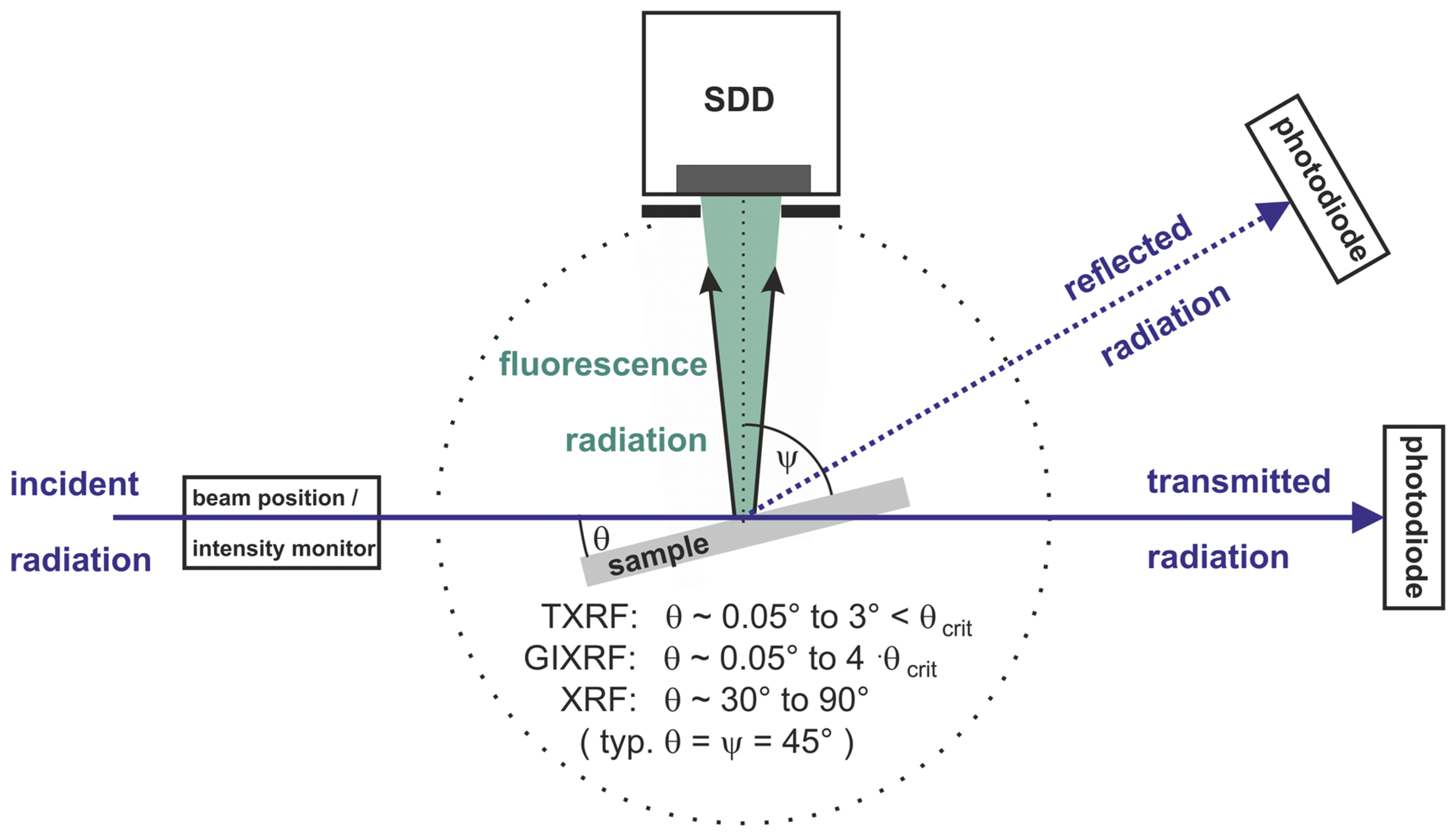
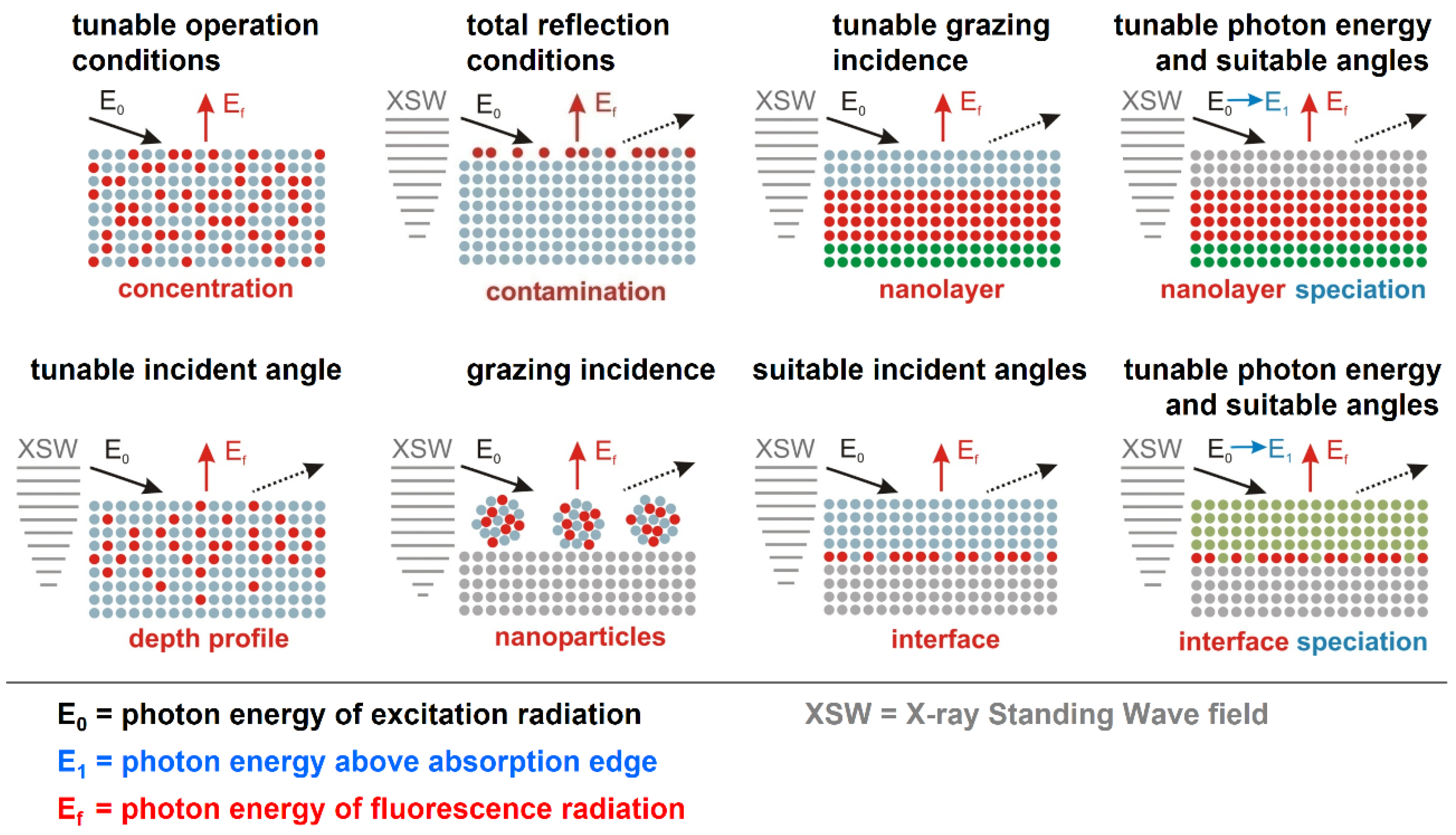

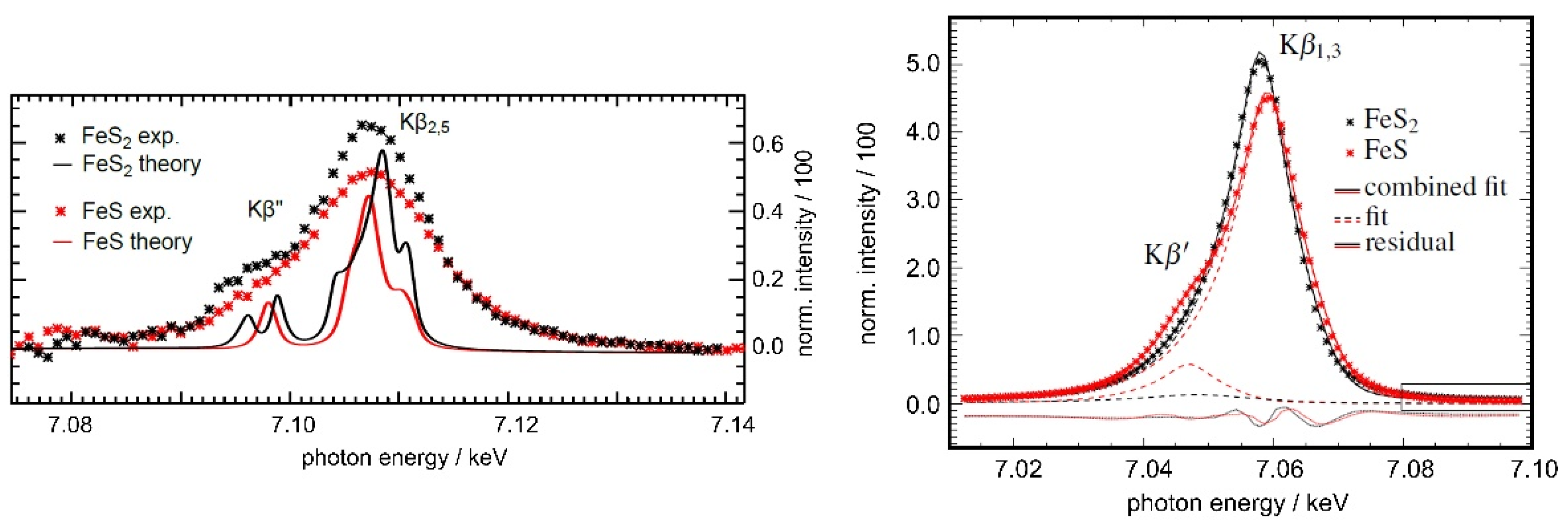

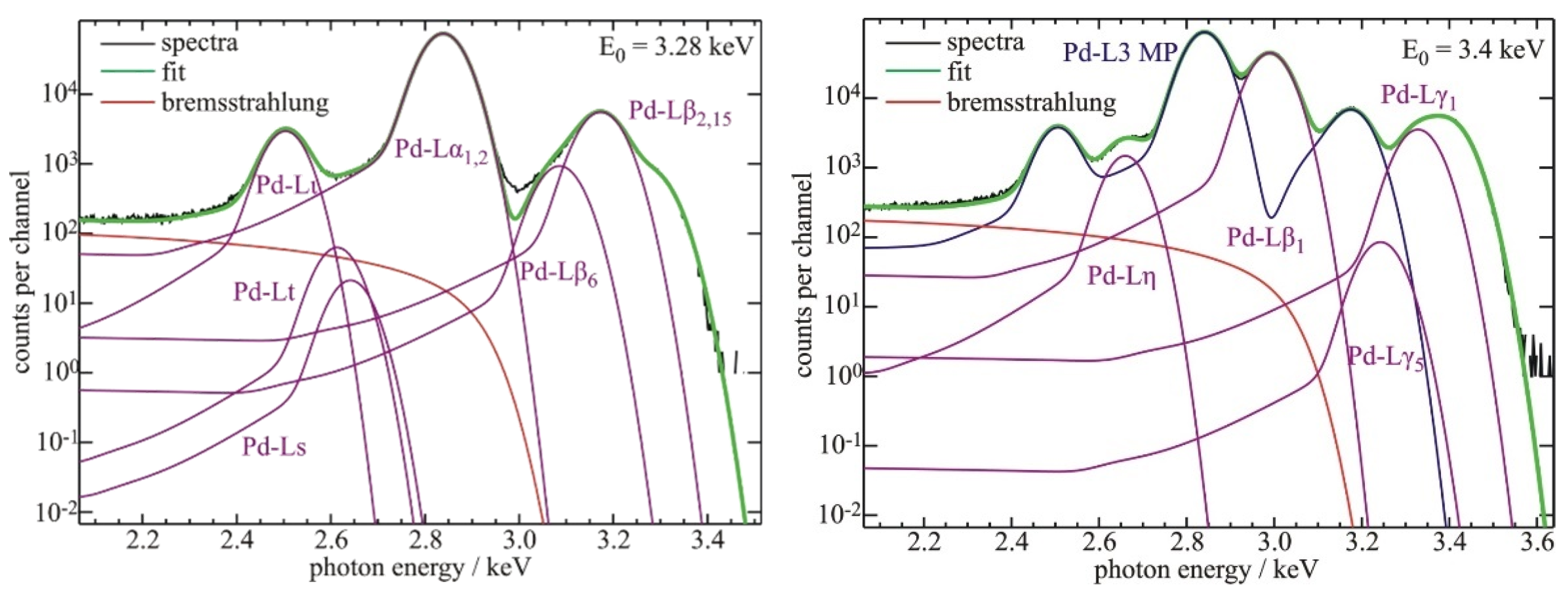
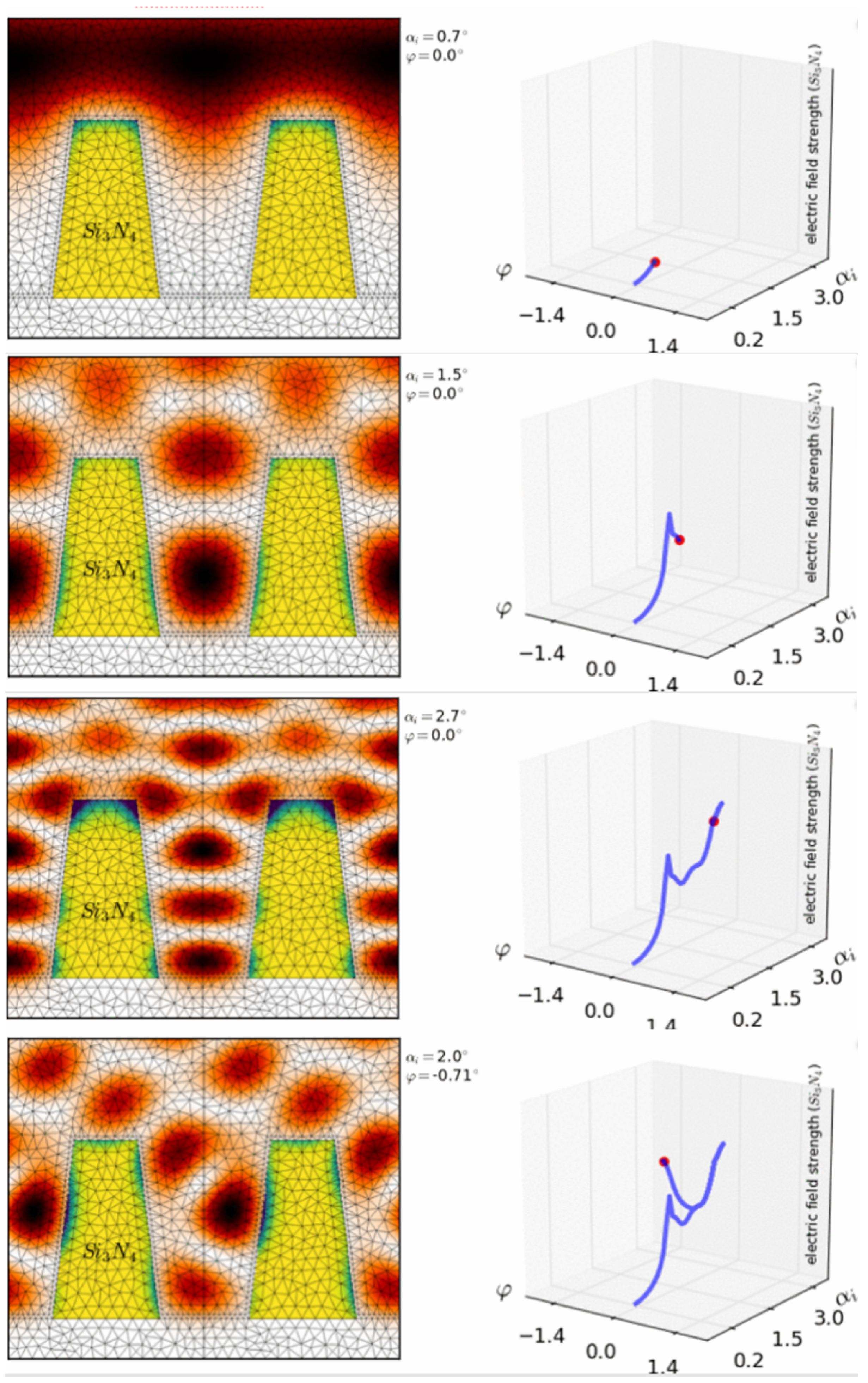

Publisher’s Note: MDPI stays neutral with regard to jurisdictional claims in published maps and institutional affiliations. |
© 2022 by the author. Licensee MDPI, Basel, Switzerland. This article is an open access article distributed under the terms and conditions of the Creative Commons Attribution (CC BY) license (https://creativecommons.org/licenses/by/4.0/).
Share and Cite
Beckhoff, B. Traceable Characterization of Nanomaterials by X-ray Spectrometry Using Calibrated Instrumentation. Nanomaterials 2022, 12, 2255. https://doi.org/10.3390/nano12132255
Beckhoff B. Traceable Characterization of Nanomaterials by X-ray Spectrometry Using Calibrated Instrumentation. Nanomaterials. 2022; 12(13):2255. https://doi.org/10.3390/nano12132255
Chicago/Turabian StyleBeckhoff, Burkhard. 2022. "Traceable Characterization of Nanomaterials by X-ray Spectrometry Using Calibrated Instrumentation" Nanomaterials 12, no. 13: 2255. https://doi.org/10.3390/nano12132255
APA StyleBeckhoff, B. (2022). Traceable Characterization of Nanomaterials by X-ray Spectrometry Using Calibrated Instrumentation. Nanomaterials, 12(13), 2255. https://doi.org/10.3390/nano12132255




